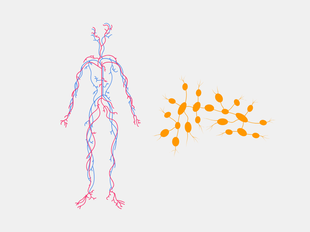Where does ovarian cancer spread?
Ovarian cancer can spread beyond the ovaries and into other parts of your body. This is known as metastatic ovarian cancer, an advanced stage of the disease where cancer cells are found in other organs, in fluid around the lungs, in the liver or in lymph nodes outside the abdomen. How far the cancer has spread is referred to by the stage, which is numbered from I-IV (1 –4).
So where does ovarian cancer spread to, what organs does it reach first and how fast does the disease spread?
How does ovarian cancer spread?
Ovarian cancer symptoms are notoriously difficult to spot as signs of the disease like persistent bloating, nausea and needing to wee more often can be associated with other, more common conditions such as hormonal fluctuations in menopause or pelvic pain from chronic diseases like endometriosis.
However, if not caught in its early stage, ovarian cancer commonly spreads beyond the ovaries. Ovarian cancer cells can spread through the body in a few different ways. Cancer cells may break off from the original tumour and travel
- Directly through your pelvis and abdomen to nearby organs
- Through your lymphatic system (part of your immune system)
- Through your bloodstream
Is it only metastasised ovarian cancer that can spread?
The word “metastasised” means that the ovarian cancer has spread outside of the ovary and started to grow as secondary tumours. Ovarian cancer is a type of cancer that often spreads in the body. By examining the cells under the microscope, specialist doctors can tell that these are ovarian cancer cells that have spread, rather than a cancer that has started in that organ.
For example, ovarian cancer cells that have spread to the liver look like ovarian cancer cells under the microscope. This means sometimes cancer cells are found and must be traced back to where the cancer started (the primary tumour).
If ovarian cancer cells have moved to other areas of your body, it doesn’t mean they’ve formed new solid tumours.
Due to the difficulties of diagnosing ovarian cancer though, when patients finally receive a diagnosis, more than 70%* of people will have metastasized ovarian cancer.

Diagram of organs, including ovaries
Common areas for ovarian cancer to spread to
How ovarian cancer spreads through the body, varies from person to person, but the disease usually follows a similar pattern moving to your pelvis, then to further areas of your abdomen, your lymph nodes and then to your liver.
Ovarian cancer in your pelvis
When the cancer has spread outside the ovary into the pelvis (the area between your hip bones), this is known as Stage 2 ovarian cancer. The cancer may be affecting tissues and organs in the pelvis, such as the womb, bladder or bowel. Ovarian cancer isn’t often diagnosed at stage 2, because the lining of the pelvis and abdomen are not separated. The cancer will usually spread to the lining of the abdomen and lymph nodes in the abdomen at the same time as the pelvis, and this means the cancer is stage 3.
Ovarian cancer in your bladder
In the early stages of ovarian cancer, the growing tumour can press on your bladder making it feel fuller and giving you the feeling that you to urinate (wee) more often. These symptoms can also be due to cancer pressing on or near the ureters, the tubes that carry urine from your kidney to your bladder, or from fluid building up in your tummy (ascites).
This feeling of needing to urinate more often can also result from cancer growing on the surface of the bladder itself, and this would mean the cancer is stage 2.
Ovarian cancer in your uterus
Ovarian cancer that had spread to tissues and organs in the pelvis (the area between the hip bones) is called stage 2. Stage 2a ovarian cancer is when the ovarian cancer has spread to the uterus (womb) or fallopian tubes. Stage 2b is when the tumour has spread into other pelvic tissues such as the bladder.
Ovarian cancer in your lymph nodes

Lymphatic drainage system diagram
The lymphatic system is part of your immune system and carries lymphatic fluid around your body. Your lymph nodes are small glands that contain white blood cells and filter cancer cells and bacteria and help fight infection. You have many lymph nodes in your body. Cancer can start in the lymph nodes, and this is called lymphoma. Cancer can also spread from a tumour somewhere else, travel through the lymphatic system and spread to the lymph nodes. Usually, cancer will spread to the lymph nodes close to the original cancer. To work out if there is cancer in a lymph node, your doctors will need to do a biopsy.
The lymph nodes at the back of your tummy are called the retroperitoneal lymph nodes. If ovarian cancer has spread to these lymph nodes, then the cancer is stage 3a1.
This is the most common stage at which ovarian cancer is diagnosed.
If you have stage 3 ovarian cancer, you may be offered surgery and chemotherapy. This treatment may be delivered as chemotherapy before surgery and the rest of the course afterward. In some cases, chemotherapy alone may be the best treatment.


